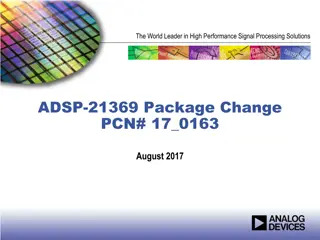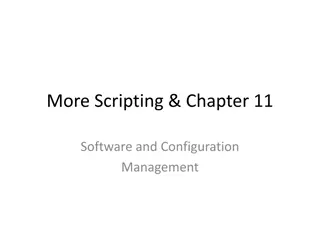Learning-Based Prediction of Package Power Delivery Network Quality
This study presents a learning-based approach for predicting Package Power Delivery Network (PDN) quality, addressing challenges in manual design cycles and tool discrepancies. Motivation, challenges, related works, and proposed methodology are discussed, highlighting the prediction of post-layout inductance values and correlation between tools. The goal is to enhance early filtering of pinmaps and improve PDN specifications.
Download Presentation

Please find below an Image/Link to download the presentation.
The content on the website is provided AS IS for your information and personal use only. It may not be sold, licensed, or shared on other websites without obtaining consent from the author. Download presentation by click this link. If you encounter any issues during the download, it is possible that the publisher has removed the file from their server.
E N D
Presentation Transcript
Learning-Based Prediction of Package Power Delivery Network Quality Yi Cao , Andrew B. Kahng , Joseph Li , Abinash Roy Vaishnav Srinivas and Bangqi Xu UC San Diego, Qualcomm Technologies, Inc.
Outline Motivation Learning-based PDN Modeling Correlation Methodology with Signoff Tool Experiments Conclusion and Future Works 2
Motivation Package (PKG) Power Delivery Network (PDN) Deliver power to critical computing blocks in SoC Multi-week manual design cycle with optimization Layers of the PKG Layers of the PCB Among RCL components, L (inductance) is the most difficult part to model Terms: bumps, balls, pinmap 3
Challenges Costly pinmap (of -bump and solder ball) evaluation No pre-layout pinmap quality assessment Expensive manual layout iterations Discrepancy in tools introduces more iterations Quick simulation tools used in design phase Golden extraction tools used for signoff The 95th percentile of absolute percentage error is 82.6% 4
Related Works Lumped element model [Tsai96][Mandic14] lump components in the system E.g., lumped -bumps and BGA balls Not accurate: does not understand distributed nature of PDN runtime and accuracy! Tradeoff between Distributed model & s-parameter model [Brennan79] propose partial element equivalent circuit with RLC components [Tsai96] treat PDN as black box and construct S-parameter matrix Does not scale well as design size increases Question: What do designers want beyond these? Answers: i. Pre-layout pinmap quality assessment ii. Better runtime-accuracy tradeoff Pareto 5
Our Work First to propose a modeling methodology to predict post-layout inductance values for each bump at pre- layout stage Enables early filtering and improvement of pinmaps that would otherwise lead to failure to meet PDN specifications, at pre-layout stage Apply our methodology to improve post-layout bump inductance prediction Extend our methodology to correlate bump inductance values from Quick tool to Golden tool 6
Outline Motivation Learning-based PDN Modeling Modeling Parameters Modeling Methodology Reporting Metrics Correlation Methodology with Signoff Tool Experiments Conclusion and Future Works 7
Modeling Parameters Three sets of parameters Parameter Set Pinmap-dependent (PiM) Design-dependent (Des) Layout-dependent (Lay) Availability Pre-layout Pre-layout Post-layout Use of parameter categories Parameter Sets PiM + Des PiM + Des + Lay PiM + Des + Lay Model Pre-layout bump inductance model Post-layout bump inductance model Quick tool to Golden tool correlation model 8
Modeling Parameters Index Parameter Description Type Distance to closest GND ball P1 PiM ???????? Distance to closest VDD ball P2 PiM ???????? Distance to closest GND bump P3 PiM ???????? Array of #bump from same supply rail within radius of {1,2,3,4} bump pitches Array of #supplyrail within radius of {1,2,3,4} pitches #???????[] P4 PiM P5 PiM #??????????[] Array of #bump in different supplyrail within radius of {1,2,3,4} bump pitches Thickness of the PKG design Derived per-bump current Number of metal layers used Array of metal utilization within radius of {1,2,3,4} bump pitches Array of via count within radius of {1,2,3,4} bump pitches Array of track count within radius of {1,2,3,4} bump pitches #?? ??????[] P6 PiM P7 P8 P9 Des Des Des ? ??????? ??????? #????? ????[] P10 Lay ??????[] P11 Lay ????????[] P12 Lay 9
Parameter Importance Analyses Remove one individual parameter at a time Up to 135% RMSE degradation Remove one parameter set at a time Up to 170% RMSE degradation 10
Modeling Flow Raw inputs include hundreds of pin locations Need for derived parameters Modeling Flow Modeling techniques Artificial Neural Network (ANN) Support Vector Machine (SVM) Multivariate Adaptive Regression Spline (MARS) Metamodeling technique Piecewise-linear (PWL) hybrid surrogate modeling (HSM) 11
Reporting Metrics We use the following metrics to evaluate performance of our models Notation ?2 AAPE (%) Meaning Coefficient of determination Average absolute percentage error 90% percentile value of sorted overestimating percentage errors 90% percentile value of sorted underestimating percentage errors 95% percentile value of sorted overestimating percentage errors 95% percentile value of sorted underestimating percentage errors 90? -pct Worst Overestimate (%) 90? -pct Worst Underestimate (%) 95? -pct Worst Overestimate (%) 95? -pct Worst Underestimate (%) Note: We are not able to provide absolute errors due to product confidentiality constraints 12
Outline Motivation Learning-based PDN Modeling Correlation Methodology with Signoff Tool Experimental Results Conclusion and Future Works 13
Correlation Methodology with Signoff Tool Use layout information from design to compensate the difference (error) between the Quick tool and Golden tool Derived inputs (P1 P12) Quick tool result Golden tool result Correlation Model Training Training Derived inputs (P1 P12) Quick tool result Predictive Correlation Model Predicted Golden tool value Testing 14
Outline Motivation Learning-based PDN Modeling Correlation Methodology with Signoff Tool Experiments Design of Experiment Experimental Results Conclusion and Future Works 15
Experiments Designs 17 industry PKG designs 2-layer, 3-layer and 4-layer designs Various bump / ball pitch sizes Tools Quick tool: A commercial tool widely used in industry for design phase inductance simulation Take ~0.5 hours to evaluate each design Golden tool: A commercial tool widely used in industry for signoff inductance extraction Take at least 0.5 days to evaluate each design Question: What do designers want beyond they have now? Answers: i. Pre-layout pinmap quality assessment ii. Better runtime-accuracy tradeoff Pareto 16
Design of Experiment Pre-layout pinmap quality assessment Achievable bump inductance model (pre-layout) Given: PiM and Des parameter sets Predict: achievable bump inductance Usage: Pre-layout pinmap filtering Better runtime-accuracy tradeoff Pareto Actual bump inductance model (post-layout) Given: PiM, Des and Lay parameter sets Predict: actual bump inductance Golden and Quick Correlation model (post-layout) Given: PiM, Des,Lay parameter sets and Quick tool inductance value Correlate: Quick tool result to actual bump inductance Usage: Better design-phase inductance estimation Note: actual bump inductance is extracted by Golden tool at post-layout stage 17
Result: Achievable Bump Inductance Model Pre-layout pinmap quality assessment Achieve AAPE of 21.2% and 18.7% for training and testing Enable pinmap filtering based on achievable PDN quality Metric ?2 AAPE (%) Training 0.89 21.2 54.7 -34.6 70.6 -43.3 Testing 0.90 18.7 46.7 -32.4 59.1 -37.6 90? -pct Worst Overestimate (%) 90? -pct Worst Underestimate (%) 95? -pct Worst Overestimate (%) 95? -pct Worst Underestimate (%) 18 Note: Our model takes 7.5 hours for training and approximately 270 seconds for every 1K data points for inference
Result: Actual Bump Inductance Model Better runtime-accuracy tradeoff pareto Achieve AAPE of 13.5% and 19.3% for training and testing Already better than Quick tool result(!) Metric ?2 AAPE (%) Quick 0.77 33.2 97.6 Training 0.97 13.5 32.2 -24.9 41.2 -33.7 Testing 0.92 19.3 48.0 -32.5 62.9 -40.6 90? -pct Worst Overestimate (%) -56.9 90? -pct Worst Underestimate (%) 95? -pct Worst Overestimate (%) 125.1 -61.5 95? -pct Worst Underestimate (%) 19 Note: Our model takes 7.5 hours for training and approximately 270 seconds for every 1K data points for inference
Result: Golden and Quick Correlation Model Better runtime-accuracy tradeoff pareto Comparison between Quick tool and Correlation model Significantly close the gap between Quick tool and Golden tool(!) Metric ?2 AAPE (%) Quick 0.77 33.2 97.6 Corr. 0.95 15.4 48.6 -37.1 37.5 -28.3 90? -pct Worst Overestimate (%) -56.9 90? -pct Worst Underestimate (%) 95? -pct Worst Overestimate (%) 125.1 -61.5 95? -pct Worst Underestimate (%) Correlation Model Correlation Model Quick tool 20 Note: Our model takes 7.5 hours for training and approximately 270 seconds for every 1K data points for inference
Outline Motivation Learning-based PDN Modeling Correlation Methodology with Signoff Tool Experiments Conclusion and Future Works 21
Conclusion Pre-layout pinmap quality assessment via achievable bump inductance model Better runtime-analysis tradeoff by Learning-based bump inductance model More than 10% better than commercial Quick tool Correlation model can close the gap between Quick tool and Golden tool 17.8% better than commercial Quick tool Ongoing / Future works Enhance model robustness across different technology and testcases Build Lay parameter predictors for layout guidance Develop model-based PKG pinmap optimization 22
THANK YOU! 23
Bump Inductance Extraction (Golden tool) Output s-parameter for each bump Use Matlab to obtain total loop inductance at target frequency Only loop inductance is available (Quick tool) Output inductance report (includes each bump) Includes self inductance and total loop inductance 25























